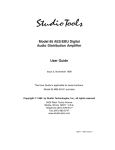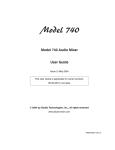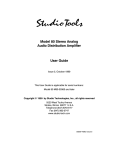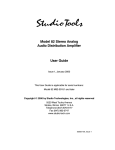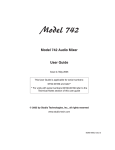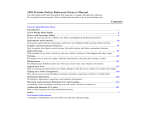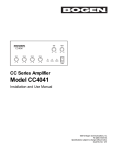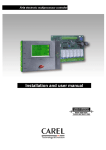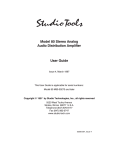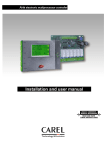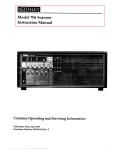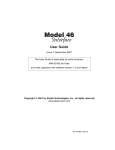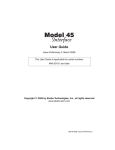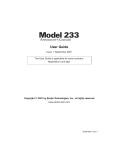Download Model 750 - Studio Technologies, Inc.
Transcript
Model 750 Model 750 Audio Mixer User Guide Issue 3, May 1997 This User Guide is applicable for serial numbers 201 and later. © 1997 by Studio Technologies, Inc., all rights reserved 5520 West Touhy Avenue Skokie, Illinois 60077 U.S.A. Telephone (847) 676-9177 Fax (847) 982-0747 www.studio-tech.com 50165-597, Issue 3 Model 750 Table of Contents Foreword Introduction .................................................................. 7 System Features .......................................................... 8 Installation .................................................................... 10 Configuration ............................................................... 16 Operation ..................................................................... 23 Technical Notes ........................................................... 36 Specifications............................................................... 38 Appendix A-1 ............................................................... 40 Appendix A-2 ............................................................... 41 Block Diagrams Model 750 User Guide Studio Technologies, Inc. Issue 3, May 1997 Page 3 Model 750 Foreword With all the pressures in life to get things done faster, work more hours, finish one job so you can get on to the next, its rare to get a chance to try and do something really right. Thats what Studio Technologies attempted to do with the Model 750 Audio Mixer. The goal was simple, to make a great audio mixer for ENG, SNG, and mobile broadcast applications. By great we meant not just meeting specifications or price issues, but to address the real needs of personnel out in the field. And not only to meet their immediate needs, but to provide resources that they can adopt and use in the future. While getting something perfect is impossible, I can say that I'm very pleased with how the product turned out, and hope that you share my enthusiasm. I think that you'll find the Model 750 a pleasure to use, providing the resources required for efficient, easy-to-use, day-after-day operation. A special thanks to Tony Raven, Chief Engineer at Shook Electronics USA. It was Tony who suggested that Studio Technologies create an audio mixer for mobile broadcast applications. He supported his idea by spending many hours with me on the telephone, reviewing lists of features, making comments, and keeping us focused on meeting the needs of field personnel. Thanks again Tony! Many other broadcast professionals contributed their time, expertise, and good ideas to help make the Model 750 what it is. Without their help the unit would definitely not be as finely tuned as it is. Thanks to you all! Many people at Studio Technologies contributed toward making the Model 750 a reality. Fred Roeck did the mechanical design and prepared the production documentation. Carrie Loving designed the graphics and provided engineering CAD support. Al Lux designed the printed circuit boards. Mitch Budniak, Ace Consulting Engineer, designed the power supply and did several overall reality reviews. Jim Cunningham, with assistance from Gary Hebert at THAT Corporation, designed the limiter/compressor circuit. Joe Urbanczyk designed the computerized test routines for the Audio Precision System One and worked on agency approvals. Larry Leviton wrote the software that drives the itty-bitty micro-controller in the Setup section800 bytes in C! Minas Serbekian and his crew built the prototype units, ensuring that the final design was "manufacturable." Please contact me with your questions, comments, and suggestions. I can be reached by voice at (847) 676-9177, fax at (847) 982-0747, or via the Internet @ www.studio-tech.com. Sincerely, Gordon Kapes President Model 750 User Guide Studio Technologies, Inc. Issue 3, May 1997 Page 5 Model 750 Model 750 Introduction The unique requirements of electronic news-gathering (ENG) trucks, satellite news-gathering (SNG) trucks, and specialized remote broadcast applications demand more than just a general-purpose audio mixer. Thats why Studio Technologies created the Model 750, a special piece of equipment for a special application. Only by taking the time to speak with industry professionalsdesigners of ENG and SNG vehicles, along with numerous field technical personnelwere the necessary specifications established. Using that information as a road map to guide the process, additional features, operating ergonomics, and overall look-and-feel issues were addressed. The result is a high-performance, easy-to-use audio mixer expressly designed to go on-theroad. What This User Guide Covers This User Guide is designed to assist you when installing, configuring, and using the Model 750 Audio Mixer. A limited amount of background technical information is also provided. Should you require detailed technical information please refer to the Model 750 Service Guide. The Service Guide contains detailed service information, including schematic diagrams. The Service Guide is not shipped with each Model 750, but is available from the factory upon request. Figure 1. View of Model 750 Front Panel Figure 2. View of Model 750 Back Panel Model 750 User Guide Studio Technologies, Inc. Issue 3, May 1997 Page 7 Model 750 System Features Mic/Line Inputs Four transformer-coupled input channels are provided for connection to microphone or line-level signals. The circuitry is ruggedized for reliability under tough operating conditions. A full set of features is provided for each input channel, including selectable input sensitivity, +48V phantom power, low-cut filter, phase reverse, level control, and pan pot. For operator assistance, a bi-color LED provides signal present and peak level indication. Two illuminated push-button switches control the routing of the input signal to the main and auxiliary (AUX) audio buses. For convenience the four mic/line input sensitivity buttons, like all the Model 750s operator controls, are located on the front panel. Stereo Line Inputs Two stereo line-level input channels are provided, and are intended for connection with audio signals associated with video playback. The channels support real world broadcast applications, where left and right signals may, or may not, be an actual stereo pair. Routing buttons allow each left and right input to be assigned to the left output bus, to the right output bus, to both output buses, or muted. A level control, along with a bi-color signal present/peak LED, supports each left and right input. Two illuminated buttons control the routing of the signals to the main and AUX audio buses. Main Output Signals from the mic/line input channels, stereo line input channels, and the setup section (discussed later) combine to Issue 3, May 1997 Page 8 create the main audio output. The main output bus is stereo, but can be used to create two independent monaural audio mixes. Two studio-quality, stereo limiter/ compressor circuits are provided to control the dynamic range of the main audio bus. Far from a simple clipper, each limiter/compressor circuit utilizes a sophisticated laser-trimmed voltage-controlled amplifier (VCA) integrated circuit for quiet, low-distortion operation. For installation flexibility, three sets of stereo output circuitry provide access to the main stereo bus: two are electronically balanced, linelevel; the third is transformer-balanced, with its output level selectable for mic or line. AUX Output The Model 750 provides a second stereo audio bus that can be configured to operate in either of two modes: as an auxiliary (AUX) output or as a monitor interrupt function. In the AUX output mode special applications are easily supported, such as creating a mix-minus feed or serving as a second stereo output for on-air use. Signals from the mic/line input channels, stereo line input channels, and the setup section can be assigned to the AUX bus. Access to the AUX bus is provided by means of an electronically-balanced, linelevel output. In most cases, however, the AUX interrupt mode will be selected, allowing the normal monitor source to be interrupted and the AUX signal monitored in its place. Model 750 operators will find this function extremely useful, enabling one or more of the input channels, or the setup section, to be monitored without interfering with signals assigned to the main output bus. Two DIP switches, accessible from the Model 750 User Guide Studio Technologies, Inc. Model 750 front panel, allow the interrupt function to be configured; one switch selects whether the monitor speaker output will be interrupted by the AUX signal, the other whether the headphone output will be interrupted. Configurable Outputs Four monaural, balanced, line-level outputs can serve in a wide range of installation-specific applications. DIP switches, located on the back panel, are used to select from the five available signal sources: main output left, main output right, AUX output left, AUX output right, and mic/line input channel direct. The DIP switches can be set to provide additional stereo outputs, create monaural outputs from the main or AUX outputs, or to provide direct outputs from the mic/line input channels. Monitor Section Reminiscent of much larger audio consoles, the Model 750s monitor section gives the operator an extensive set of resources. Separate stereo outputs and level controls are provided for connection to a monitor amplifier and headphones. In addition to monitoring the main and AUX audio buses, provision has been made for monitoring two external audio sources. These stereo inputs are intended to be connected to off-air, microwave, or satellite receivers. External Monitor Input 1 is compatible with +4 signals, while External Monitor Input 2 can be set, using a front-panel DIP switch, for 10 or +4 compatibility. Multiple sources can be simultaneously selected for monitoring. This can prove useful by allowing, for example, an operator to simultaneously monitor a local mix Model 750 User Guide Studio Technologies, Inc. and an externally-provided mix-minus signal. A mono function allows the monitored audio source to be checked for phase cancellation problems and acceptable sum-to-monaural performance. The AUX interrupt mode allows monitoring of selected input channels and the setup section without interfering with normal operation of the main audio bus. For operator assistance, the meters can be configured to monitor the AUX bus whenever the AUX interrupt mode is active. Mechanical VU-type meters, along with peak level LED indicators, provide a userfriendly indication of audio-signal levels. Fanatics for addressing the details, Studio Technologies has even eliminated the issue of burned-out meter-scale illumination by implementing a solid-state, LEDbased lighting scheme. Setup Section Unique to the Model 750 are the features provided by the setup section, the highlight being the ability of the operator to record and playback three voice identification segments. The Left+Right segment allows a voice message of up to 12 seconds in length to be recorded, with playback going to the left and right output channels. The Left Only and Right Only segments allow recording of up to 4 seconds each, with playback going only to their respective channels. The voice segments can prove useful, allowing the facilities that receive the vehicles signal (generally provided by microwave or satellite links) to quickly learn more about the origin of the transmission. Information such as vehicle identity, physical location, the names of technical and on-air personnel, mobile Issue 3, May 1997 Page 9 Model 750 telephone numbers, and left and right channel identifiers can easily be sent. The voice audio source is selectable, with the choices being either the internal microphone or an externally-connected signal. The setup section also contains a digitallycontrolled sine-wave generator which, under software control, produces a 0-level single-tone reference and multistep tone sequences. The single-tone output is selectable for either 400Hz or 1kHzthe two industry-standard frequencies. The tone sequences allow frequency response testing of a transmission chain, with the choice of either a basic or an advanced sequence. In the basic setting a 1kHz 0-level reference is generated, followed by individual 10kHz, 1kHz, and 100Hz tones. In the advanced setting a 1kHz reference is generated, followed by 14 individual tones, ranging from 15kHz to 50Hz. At the end of each sequence a left/ right channel identifier is generated. It consists of a short burst of 700Hz sent only to the left channel, followed by two short bursts of 700Hz to the right channel. While the voice and tone setup signals can be assigned to the main and AUX output buses, a direct line-level stereo output is also provided. This allows the generation of setup and test signals without interfering with normal operation of the main and AUX audio buses. Talk Back The Model 750 includes a talk back function. Two push-button switches allow the selected voice source to be routed to the setup direct output and/or the main and AUX outputs. Issue 3, May 1997 Page 10 Mounting, Connectors, and Mains While the Model 750 is loaded with features, it only requires two spaces in a standard 19-inch rack. XLR-type and ¼-inch 3-conductor audio connectors are used for audio interconnection. Mains power is factory configured for 100, 120, or 220/240V, 50/60Hz. Installation In this section you will be installing the Model 750 Audio Mixer in an equipment rack. Input and output connections will be made using the Model 750s multitude of jacks. AC mains power will then be connected. During normal operation, no access to the back panel of the Model 750 is required. However, there are five trim potentiometers that may need to be adjusted prior to the Model 750 going into service, depending on the requirements of the specific installation. Since part of the calibration process involves observing the frontpanel-mounted VU meters, you may want to perform the calibration process on-thebench, prior to mounting the Model 750 in an equipment rack. In addition, there are a number if DIP switches that may need to be set. Refer to the Configuration section of this guide for details. Realistically, as long as you can get the assistance of another person for about 5 minutes, go ahead and install the Model 750, wire it up, and then worry about the calibration. You will need a highly-skilled and articulate helper, capable of describing the position of the VU meters indicators with words such as: too high, down a little, almost, up a tad, and OKyouve got it! Model 750 User Guide Studio Technologies, Inc. Model 750 Locating the Unit Physical access and mechanical noise are the primary factors when choosing a mounting location. By its very nature as an audio mixer, an operator will need easy access to all the controls, as well as good sight lines to the meters. In most cases the internal microphone, located on the upper right side of the front panel, will be used, so be careful that you dont have a cooling fan blowing directly onto it. As a device that contains high gain audio stages, hum and noise pickup is possible through the chassis and associated cabling. Locating the unit away from devices that radiate strong AC fields is an excellent idea. The left side of the Model 750, which contains the microphone preamplifiers, is the area most sensitive to noise pickup. Also, it is possible that the Model 750s power transformer may radiate energy into adjacent equipment. It is located at the right, bottom rear corner of the unit, and may need to be physically isolated from sensitive equipment, especially videotape recorders. Mounting The Model 750 is intended for rack mounting, requiring two standard rack spaces (3.5 inches). It weights approximately 14 pounds (6.4kg), and operates on either 100, 120, or 200/240V, 50/60Hz. The unit is secured to the front mounting rails of an equipment rack using two mounting screws per side. Audio Inputs and Outputs The Model 750s audio input and output connections are made using 3-pin XLRtype and ¼-inch 3-conductor phone jacks. Model 750 User Guide Studio Technologies, Inc. Balanced Connections (Input & Output) Ring () Tip ( + ) Sleeve (Shield) (Switchcraft No. 297, Neutrik NP3C, or equivalent) Figure 3. Recommended phone plugs Dont be concerned about our use of phone jacks as part of a professional product. The jacks used feature goldplated contacts for high reliability. As much as we wanted to, there was simply no room in only two rack spaces to use all XLR-type connectors. Caution: For reliable audio interconnection, the phone plugs you use must comply with industry-standard RS-453. Switchcraft No. 297 or Neutrik NP3C are highly recommended. Mic/Line Inputs The Model 750 contains four input channels that are compatible with microphone or line-level sources. Each of the four Mic/Line inputs use a single 3-pin female XLR-type connector. Prepare the mating connectors (males) so that pin 2 is signal high (+ or hot), pin 3 is low ( or cold), and pin 1 is shield. It is expected that the mic/line inputs will be wired to input/output connector panels located on the side or rear of the vehicle. Its also nice to have one or two of the inputs multed to connectors inside the vehicle, allowing the quick connection of Issue 3, May 1997 Page 11 Model 750 microphone or line-level signals. To minimize noise and other problems, it is recommended that the mic/line signals arent wired by way of points on the patch bay. Stereo Line Inputs The Model 750 contains two stereo linelevel input channels. They are intended for connection to sources located within the vehicle, specifically the audio output channels from videotape machines. The direct-coupled, electronically-balanced circuitry has extremely low noise, high common-mode rejection, but no special protection from overvoltage or static. (Dont get us wrongthe stereo line input circuitry is better than whats found on most audio mixers available today theyre just not as tough as the mic/line inputs!) The stereo line input circuitry is intended for connection to balanced, linelevel signals with a nominal operating level of +4dBu. Each stereo line input channel uses two 3-pin female XLR-type connectors. Prepare the mating connectors (males) so that pin 2 is signal high (+ or hot), pin 3 is low ( or cold), and pin 1 is shield. With an unbalanced source connect pin 2 to high (+ or hot), and pins 1 and 3 to shield. If connecting to an unbalanced source in this manner results in hum or noise, connect pin 2 to high (+ or hot) and pin 3 to shield; leave pin 1 unterminated. For flexibility of use it is recommended that the stereo line input connections be routed through points on the patch bay. Main Outputs The Model 750 contains three sets of stereo outputs associated with the main audio bus. Main Outputs 1 and 2 are Issue 3, May 1997 Page 12 electronically balanced, have a nominal level of +4dBu, and are capable of driving balanced or unbalanced loads of 600 ohms or greater. Main Output 3 is transformer balanced, with its output level selectable, using a front-panel button, for microphone or line level. It is capable of driving full level into balanced or unbalanced loads of 2k ohms or greater. Main Output 1 and 2 Main Output 1 and 2 are intended for connection to devices located within the vehicle. It is recommended that either Main Output 1 or 2 be used as the on-air source. Each output utilizes two ¼-inch 3-conductor phone jacks for interconnection. Prepare the mating connectors (plugs) so that tip is signal high (+ or hot), ring is low ( or cold), and sleeve is shield. Whether these outputs are wired via the patch bay will depend on the specific installation. Note that while the electronically-balanced output circuitry is capable of driving loads of 600 ohms or greater, the output level will drop slightly as the load impedance approaches 600 ohms. A 0.5dB difference in output level can be expected as the load impedance changes from 10k ohms to 600 ohms. While balanced operation is preferred, unbalanced operation is not a problem for the electronically-balanced output circuitry. To connect to an unbalanced load connect the tip to high (+ or hot), and both the ring and sleeve to shield. For optimal unbalanced operation, it is important to connect both the ring and sleeve together on the plug that mates with the Model 750. Model 750 User Guide Studio Technologies, Inc. Model 750 Main Output 3 Main Output 3 has been optimized for connection to devices located external to the vehicle. This ruggedized, transformer-coupled stereo output is selectable, using a front-panel button, for microphone or line level. It is recommended that Main Output 3 be wired, via points on the patch bay, to the vehicles input/output connector panel. Two 3-pin male XLR-type connectors are used for interconnection. Prepare the mating connectors (females) so that pin 2 is high (+ or hot), pin 3 is low ( or cold), and pin 1 is shield. Main Output 3 was specifically designed to provide a fully-isolated output with good sonic performance. It was NOT designed to drive full level into 600 ohm loads! While a 600 ohm load can be connected without damage, a 2dB level drop should be expected. Used with 2k ohm or greater loads, Main Output 3 will provide its full specified performance. AUX Output A stereo output is provided to give access to the Model 750s AUX audio bus. It is intended that the AUX audio output will be connected to devices within the vehicle. The electronically-balanced, line-level outputs have a nominal level of +4dBu, and are capable of driving balanced or unbalanced loads of 600 ohms or greater. Two ¼-inch 3-conductor phone jacks used for interconnection. Prepare the mating connectors (plugs) so that tip is signal high (+ or hot), ring is low ( or cold), and sleeve is shield. To connect to an unbalanced load connect the tip to high (+ or hot), and both the ring and sleeve to shield. Model 750 User Guide Studio Technologies, Inc. Even if there are no immediate plans to connect the AUX audio outputs to external devices, it is recommended that they be terminated on patch points. In this manner they will be accessible for those one-in-a-million situations that seem to arise far too frequently! Configurable Outputs Each of the four configurable outputs is electronically balanced, has a nominal level of +4dBu, and is capable of driving balanced or unbalanced loads of 600 ohms or greater. The outputs are intended to be used only within the vehicle. DIP switches are associated with each configurable output. Details on using these switches can be found in the Configuration section of this guide. Each of the configurable outputs is accessible via a ¼-inch 3-conductor phone jack. Prepare the mating connectors (plugs) so that tip is signal high (+ or hot), ring is low ( or cold), and sleeve is shield. To connect to an unbalanced load connect the tip to high (+ or hot), and both the ring and sleeve to shield. It is highly recommended that the configurable outputs be routed via the patch bay. Or, if there are no immediate needs for these outputs, be certain to terminate them on the patch bay for future use. Sometime, somewhere, they will get used. Setup Direct Output Direct access to the setup sections voice and tone signals is provided by means of a stereo line-level output. As one of the unique features of the Model 750, it should definitely be utilized! This output is intended to be connected to the audio input associated with the video/audio switchers Issue 3, May 1997 Page 13 Model 750 bars and tone position. For maximum flexibility, it is recommended that these signals be connected by way of the patch bay. In this way they can be accessed for test and calibration purposes. The electronically-balanced, nominal +4dBu outputs are accessible via two ¼-inch 3-conductor phone jacks. The circuitry is capable of driving balanced or unbalanced loads of 600 ohms or greater. Prepare the mating connectors (plugs) so that tip is signal high (+ or hot), ring is low ( or cold), and sleeve is shield. To connect to an unbalanced load connect the tip to high (+ or hot), and both the ring and sleeve to shield. Two trim potentiometers are used to set the output level of the setup direct output. Refer to the Configuration section of this guide for details. External Monitor Inputs Two external audio signals can be connected, allowing them to be monitored independently of the internal audio buses. It is intended that the external monitor inputs will be connected to outputs associated with off-air, microwave, or satellite receivers. Both inputs are stereo, electronically balanced, and interface using ¼-inch 3-conductor phone jacks. External Monitor Input 1 is compatible with signals that have a nominal level of +4dBu. External Monitor Input 2 is compatible with 10dBu or +4dBu signals. A DIP switch, located on the front panel of the Model 750, is used to set the input sensitivity. Refer to the Configuration section of this guide for configuration details. As an installation aid, a connection made only to the jack labeled L/MONO routes the signal to both the left and right input Issue 3, May 1997 Page 14 circuitry. This allows a monaural signal to be monitored in a 2-channel mono format. If you wish to have a mono input connected only to the left input, simply insert an unterminated plug into the associated right input jack. This will break the normal connections that link the left and right input circuits. Prepare the mating connectors (plugs) so that tip is signal high (+ or hot), ring is low ( or cold), and sleeve is shield. With an unbalanced source connect the tip to high (+ or hot), and both the ring and sleeve to shield. If connecting to an unbalanced source in this manner results in hum or noise, connect tip to high (+ or hot) and ring to shield; leave the sleeve unterminated. Monitor Output The monitor output is designed for connection to an audio power amplifier associated with a pair of monitor loudspeakers. In mobile applications it may prove common for loudspeakers with internal amplifiers, such as those from Fostex, to be connected to the Model 750s speaker output. The outputs are electronicallybalanced, line-level, and can drive balanced or unbalanced loads of 600 ohms or greater. The monitor output utilizes two ¼-inch 3-conductor phone jacks for interconnection. Prepare the mating connectors (plugs) so that tip is signal high (+ or hot), ring is low ( or cold), and sleeve is shield. To connect to an unbalanced load connect the tip to high (+ or hot), and both the ring and sleeve to shield. Whether these outputs are wired via the patch bay will depend on the specific installation. Model 750 User Guide Studio Technologies, Inc. Model 750 Record/Talk Back External Audio Input The Model 750 contains an internal microphone which is used by the setup section for voice recording, as well as by the talk back functions. In special cases it may be desirable for an external source of audio to be used in its place. A ¼-inch 3-conductor phone jack allows the connection of a line-level signal, with a nominal level range of 20 to +4dBu. Prepare the mating connector (plug) so that tip is signal high (+ or hot), ring is low ( or cold), and sleeve is shield. With an unbalanced source connect the tip to high (+ or hot), and both the ring and sleeve to shield. If connecting to an unbalanced source in this manner results in hum or noise, connect tip to high (+ or hot) and ring to shield; leave the sleeve unterminated. It is intended that a microphone associated with an intercom system headset will serve as the external audio source. Intercom stations often provide an amplified, line-level version of the mic signal. It is often referred to as a hot microphone output. A trim potentiometer is associated with the external audio input, allowing adjustment of the input sensitivity. Refer to the Configuration section of this guide for details. Information is also provided on how to set the front panel DIP switch to select the external audio input. Connecting AC Mains Power The Model 750 is factory configured to operate from AC mains power of either 100, 120, or 220/240V, 50/60Hz. In most cases, units shipped to North America are factory configured for 120V operation and are supplied with an internal 0.5A, 5 x 20mm fast-acting fuse. Units configured for 100V also utilize a 0.5A fuse. Units configured for 220/240V operation are supplied with a 0.25A, 5 x 20mm fastacting fuse. Before connecting the Model 750 to mains power, determine the actual mains voltage and confirm that the Model 750 has been configured correctly. As could be expected, an incorrect mains configuration could seriously damage the unit. Figure 4. Detail of back panel showing voltage configuration chart Model 750 User Guide Studio Technologies, Inc. Should it be necessary to change the units operating voltage refer to the Service Guide, a separate document available upon request from Studio Technologies. Issue 3, May 1997 Page 15 Model 750 The Model 750 uses an IEC standard connector to mate with the AC mains cord. Normally the cord supplied has a NorthAmerican standard plug on one end and an IEC connector on the other. In nonNorth American applications the appropriate plug must be attached. The wire colors in the mains cord will, in most cases, conform to the internationally recognized CEE color code and should be wired accordingly: Connection Wire Color Neutral (N) Live (L) Earth/Ground (E) Light Blue Brown Green/Yellow outputs is deciding which audio source, or sources, should be assigned to which output! By carefully reviewing the choices, and how their selection may benefit an installation, the power of this humble output should become apparent. These four outputs may well eliminate the need for external distribution amplifiers, combining amplifiers, and microphone preamplifiers. Because the Model 750 contains no power switch it will start operating as soon as AC mains power is connected. Configuration As in life, power leads to responsibility. The Model 750 is no exception as its features, flexibility, and operational power leads to a number of configuration issues that must be reviewed once installation has been completed. All are quite simple and, with the exception of the front panel configuration DIP switches, will only need to be addressed once. Configurable Outputs The Model 750 contains four configurable outputs, the likes of which arent found on other audio mixers. Their uniqueness may make them seem a bit confusing at first glance. However, they arent too weird, simply being electronically-balanced output circuits whose input source is selectable, rather than being fixed. The hardest part of using the configurable Issue 3, May 1997 Page 16 Figure 5. Detail of back panel showing configurable output section (typical of 4) Model 750 User Guide Studio Technologies, Inc. Model 750 The five choices are main output left, main output right, AUX output left, AUX output right, and mic/line direct: Main output left and main output right are the same signals that connect to the output circuitry associated with the main outputs. AUX output left and AUX output right are the same signals that connect to the output circuitry associated with the AUX line-level output. Mic/line direct is a signal that is derived from its associated mic/line input channel. The signal is the same as that connected to the pan-pot; post input preamplifier, low-cut filter, and phase reverse function. Configurable output 1 has access to the signal from mic/line input 1; configurable output 2 has access to the signal from mic/line input 2; etc. Using the five DIP switches associated with each configurable output, simply select the source or sources desired. Note the word sourcesmore than one source can be selected! As an example, selecting switch 3, AUX out left, and switch 4, AUX out right, will produce a monaural (L+R) version of the AUX output. Selecting switch 1, main out left, for configurable output 1, and switch 2, main out right, for configurable output 2 will result in another stereo output, viola, main output 4! It would be the authors choice to use the configurable outputs in this way: Configurable output 1 set for a mono version of the main output, configurable output 2 set for a mono version of AUX output, and configurable outputs 3 and 4 Model 750 User Guide Studio Technologies, Inc. Figure 6. Detail of back panel showing level adjustment trim pots for setup direct output set for mic/line direct outputs. Terminating on the patch bay, these four outputs could provide quite handy for those once in a blue moon situations that seem to occur about once a month! The two mic/line direct outputs may prove especially helpful, providing two channels of mic/line amplifier for general purpose or emergency use. In special situations, a signal of virtually any audio level could be bumped to nominal +4dBu. Issue 3, May 1997 Page 17 Model 750 Setup Direct Output The setup direct output is a stereo linelevel output that provides direct access to the voice and tone signals. Trim potentiometers allow adjustment of the output level from approximately 2 to +10dBu. The trim pots are located on the back panel, directly above the setup direct outputs ¼-inch phone jacks. At the factory these outputs are loaded with 100k ohms, and then the trim pots are adjusted to give an output level of +4dBu. If the setup direct output is to be used in an installation, its important that the left and right channel output levels be adjusted to precisely match the requirements of the system. Even if you simply want to use the standard output level of +4dBu, its still important to confirm the factory calibration. Also note that while the output circuitry is capable of driving loads of 600 ohms or greater, the output level will drop slightly as the load impedance approaches 600 ohms. A 0.5dB difference in output level can be expected as the load impedance changes from 20k ohms to 600 ohms. In practice, calibrating the output level is quite simple: 1. Confirm that both the left and right channels of the setup direct output are terminated with their normal load impedance. 2. Ensure that the Model 750 is connected to mains power. 3. Activate the setup sections single tone output by placing the single tone button to the on (in) position. The voice and multi-tone buttons should be in their off (out) position. Issue 3, May 1997 Page 18 4. Using an appropriate adapter cable, connect an audio level meter directly across the left channel setup direct output. Ensure that your connection does not remove the normal load! The level meter must be a precision device thats intended for audio usea general-purpose voltmeter is not adequate! 5. Carefully observing the level meter, adjust the trim pot associated with the left channel to give the desired output level. 6. Repeat steps 4 and 5, this time for the right channel. External Record/TB Audio Source During installation, an external source of audio may have been connected to serve in lieu of the Model 750s internal microphone. This audio source will be used for voice recording by the setup section, as well as by the talk back functions. The external audio source needs to have a nominal audio level of 20 to +4dBu. A trim potentiometer, located on the back panel directly above the record/TB external audio input jack, adjusts the input sensitivity of the circuitry. For correct operation it is crucial that this trim pot be adjusted so that the source audio level is matched with the requirements of the Model 750. The procedure is a bit convoluted, but not difficult: 1. Ensure that mains power is connected to the Model 750. Model 750 User Guide Studio Technologies, Inc. Model 750 2. Select the external audio source by placing front panel configuration DIP switch 1 to the down position. 3. Select the main bus as the VU meter source by placing the meter source select button to the out position. 4. Place the main output limiter/compressors to the off state by placing the button labeled LIMITER to the out position. 5. Set the main bus master output level controls to the unity gain position. The front panel contains a graphic arrow symbol and the letter U to serve as a guide. 6. Press and hold the button labeled TALK TO MAIN AND AUX. This connects the external audio source to the main and AUX audio buses. 7. With a normal voice signal coming from the external audio source, adjust the trim pot so that the VU meters deflect to the 0 VU position on signal peaks. You may want to enlist the help of another person to serve as a live audio source while you make the adjustment. It is very important that the external audio level reflect normal operationif your operators or producers love to yell and scream, set the trim pot accordingly. VU Meter Calibration Two trim potentiometers allow calibration of the VU meters normal operating level. The range of the trim pots allow 0 on the meters to represent an output signal level of 2 to +10dBu. While providing a powerful feature, these trim pots must be adjusted very carefully. Be warnedmeter calibration effects the audio performance of the entire Model 750! From the factory, the VU meters are calibrated so that 0 VU represents an output level of +4dBu on main output 1, when loaded with 100k ohms. In certain cases it may be a good idea to check the meter calibration, such as when main outputs 1 and 2 are loaded with 600 ohms, or when main output 3 is going to serve as the primary output. Figure 7. Detail of back panel showing trim pots for VU meter calibration Model 750 User Guide Studio Technologies, Inc. In some installations it may be desirable to have a level different from +4dBu, such as Issue 3, May 1997 Page 19 Model 750 0dBu, to serve as the 0 reference. While Studio Technologies is not excited about such a prospect, it can certainly be achieved. There is one serious downside to changing the nominal operating level; the limiter/compressor threshold. The limiter/compressors are designed to activate at approximately 6dB above the Model 750s internal operating level, corresponding to an output level of +10dBu. The threshold is not factory calibrated and is not easily modified in the field. If, as an example, the meters are recalibrated for a nominal output level of 0dBu, the limiter/compressors will now activate at 10dB above this new nominal level. Prior to changing the operating level, a discussion with personnel at the factory may be warranted. Call us for a chat! While not difficult, meter calibration is a bit tedious: 1. Ensure that mains power is connected to the Model 750. 2. Place the main output limiter/compressors to the off state by placing the button labeled LIMITER to the out position. 3. Activate the setup sections single tone output by placing the single tone button to the on (in) position. The voice and multi-tone buttons should be in their off (out) position. 4. On the setup section, place the main bus assignment button to the on (in) position. 5. Select the main bus as the VU meter source by placing the meter source button to the monitor (in) position and selecting main stereo. This makes the meters most accurate when they are Issue 3, May 1997 Page 20 monitoring the main bus via the monitor section. If you wish to have the meters most accurate when they are connected directly to the main bus, set the meter source button to the main (out) position. 6. Designate main output 1, 2, or, in rare circumstances, 3 as the desired primary output. This is the output that the meters will be calibrated against. If main output 3 is selected, set its output level button to the line (in) position. 7. Confirm that the left and right channels of the designated main output are terminated with their normal load impedance. 8. Using an appropriate adapter cable, connect an audio level meter directly across the left channel of the designated main output. Ensure that the meter connection does not remove the normal load. The level meter must be a precision device thats intended for audio usea general-purpose voltmeter is not adequate! 9. Carefully observing the audio level meter, set the main bus left channel master output control so that the output level matches the desired nominal operating level. In most cases this will be +4dBu. 10. Observing the Model 750s left channel VU meter, adjust the left channel meter trim pot to give 0 VU. 11. Repeat steps 8 through 10, this time for the right channel. Model 750 User Guide Studio Technologies, Inc. Model 750 tion DIP switches. One is shipped with each Model 750, being attached to the front panel by means of two screws. Where the Model 750 is physically located, and who will be operating the unit, will dictate whether the security cover remains in place or is permanently removed. In a facility where many operators have access to the unit, it may be best to set the configuration DIP switches to match the needs of most operators, then replace the cover. In a facility where only a few operators have access, such as an SNG vehicle, the cover can stay off to allow quick access to the features. A brief description of the function of each configuration DIP switch is contained on the front panel, directly above the DIP switches. A more detailed description is provided here: Figure 8. Detail of front panel showing configuration DIP switches Configuration DIP Switches Studio Technologies is sorry to report that the 8 configuration DIP switches had to be placed on the front panel. We tried to place them on the back panel where theyd be hard to reach, or inside the unit where youd never find them, but we just couldnt find the spacejust kidding! The 8 configuration DIP switches are located on the front panel where you can easily get at them. These switches allow important operating parameters to be easily configured, and then quickly changed on-the-fly as operating requirements dictate. The factory default is to have all 8 switches set to the up position. A clear plastic security cover can be used to prevent access to the configuraModel 750 User Guide Studio Technologies, Inc. 1. REC/TB AUDIO SOURCE: EXT ▼ / INT ▲ This switch selects which audio source will be used by the voice record and talk back sections. In the down position the external audio source is selected. In the up position the internal microphone will be used. Be careful with this switch! In most cases an external audio source will not be connected and the internal microphone needs to be selected for use. Its easy to accidentally set DIP switch 1 to the down position and have no source of record and talk back audio. 2. REC L+R: DISABLE ▼ / ENABLE ▲ This switch selects whether the setup sections L+R voice segment can be recorded. In the down position recording cannot take place. In the up position recording can take place. This feature can prove useful where a semipermanent L+R voice segment needs to be recorded. By placing the switch to the down position, the L+R voice segment cannot be changed. Issue 3, May 1997 Page 21 Model 750 3. REC L ONLY/R ONLY: DISABLE ▼ / ENABLE ▲ This switch selects whether the setup sections L Only and R Only voice segments can be recorded. In the down position recording cannot take place. In the up position recording can take place. This feature can prove useful where semipermanent L Only and R Only voice segments need to be recorded. By placing the switch to the down position, the L+R voice segment cannot be changed. output. Also, if the VU meter source button is set to follow the monitor section, the AUX bus signals will automatically be connected to the VU meters whenever AUX interrupt is active. 8. EXT 2 INPUT LEVEL: 10 ▼ / +4 ▲ This switch is used to select the nominal input level of external monitor input 2. In the down position the nominal input level is 10dBu. In the up position the nominal input level is +4dBu. 4. SINGLE TONE: 400HZ ▼ / 1KHZ ▲ This switch selects whether the setup sections single tone feature will generate a 400Hz or a 1kHz sine wave signal. In the down position 400Hz will be generated. In the up position 1kHz will be generated. 5: MULTI-TONE SEQUENCE: BASIC ▼ / ADVANCED ▲ This switch selects whether the setup sections multi-tone feature will generate a basic or an advanced sequence of tones. In the down position the basic sequence will be generated. In the up position the advanced sequence will be generated. Refer to appendices A-1 and A-2 for detailed descriptions of the tone sequences. 6: AUX INT SPEAKER: NO ▼ / YES ▲ This switch selects whether the AUX audio bus will automatically be selected as the audio source for the monitor speaker whenever an input channel or the setup section is assigned to the AUX bus. In the down position a signal assigned to the AUX bus will not impact the monitor speaker output. In the up position any signal assigned to the AUX bus will automatically be connected to the monitor speaker output. Also, if the VU meter source button is set to follow the monitor section, the AUX bus signals will automatically be connected to the VU meters whenever AUX interrupt is active. 7. AUX INT PHONES: NO ▼ / YES ▲ This switch selects whether the AUX audio bus will automatically be selected as the audio source for the headphone output whenever an input channel or the setup section is assigned to the AUX bus. In the down position a signal assigned to the AUX bus will not impact the headphone output. In the up position any signal assigned to the AUX bus will automatically be connected to the headphone Issue 3, May 1997 Page 22 Figure 9. Detail of front panel showing mic/ line input channel (typical of 4) Model 750 User Guide Studio Technologies, Inc. Model 750 Operation While the Model 750 Audio Mixer is quite simple to operate, there are nuances to its design that make a detailed discussion worthwhile. While you can certainly consider the Model 750 a small audio mixer, its roots are from the much larger audio consoles that are used in broadcast and recording settings. Well start with a discussion of the individual sections that make up the Model 750. Then well review how the sections work together to become your audio master control. Mic/Line Inputs Four identical input channels are provided, each being compatible with a microphone or line-level signal. A detailed description of one mic/line channel follows: Input Sensitivity The mic/line button is used to select the sensitivity of the input circuitry. In the mic (out) position, the expected nominal input level is 55 to 35dBu. In the line (in) position, a 40dB pad is inserted into the circuit, making the expected nominal input level 15 to +5dBu. The input circuitry is compatible with a wide range of signal levels and is protected from overload. In most cases, an input signal whose nominal level is outside the expected range shouldnt pose a problem. Phantom Power The button labeled +48V is used to activate phantom power for use with condenser-type microphones. The +48V power supply and related circuitry was carefully designed to allow virtually any microphone that requires phantom power to operate correctly. When the button is in Model 750 User Guide Studio Technologies, Inc. the off (out) position, power is not applied to the mic/line input connector. When the button is in the on (in) position, and the mic/line button is in the mic (out) position, +48Vdc is applied to the input connector. When the mic/line button is set for mic, and a condenser microphone is connected, changing the phantom power on/off status may result in loud pops being generated. As such, it is best not to change the position of the +48V button while its associated input is live or on-air. While it is a good idea to leave the +48V button in the off position except when phantom power is required, no damage should occur to dynamic or ribbon microphones when theyre connected to the input with phantom voltage present. (Wow, thats why they call it phantom powerif a device doesnt require power it doesnt see it!) Low-Cut Filter The button associated with the bent line graphic symbol is used to select the lowcut filter function. (If you are a stickler for semantics, its actually a high-pass filter function!) In the off (out) position the filter is not placed in the audio path, leaving the signal essentially flat. In the on (in) position the signal is routed through the filter circuit, removing low-frequency energy. The filter is useful for eliminating wind noise, traffic rumble, and AC mains hum. It was carefully designed to give a steep slope (18dB/octave), with the 3dB point at 85Hz. For most voice applications the filter can be left activated. For wide-bandwidth signals, such as music, the filter should be used only as necessary. Issue 3, May 1997 Page 23 Model 750 Changing the on/off status of the low-cut filter will result in little or no noise being added to the audio signal. While it is better to set the filters button to the desired position prior to being live, it can certainly be used at any time. Phase Reverse The button associated with the circlewith-a-slash graphic symbol is used to select the phase reverse function. (Many people will know this as, and is technically, a polarity invert or polarity reverse function.) In the normal (out) position, the mic or line input signal maintains the same polarity from input all the way through to the main and AUX audio buses. In the reverse (in) position, the signal is inverted by 180 degrees. Changing from normal to reverse, or vice-versa, will generally result in little or no audio clicks or pops, being generated, allowing the function to be used during on-air situations. This function can be useful in situations where multiple microphones are present, and signal cancellation problems occur. The cancellation can be caused by miswired interconnecting cables, faulty equipment, or acoustic conditions related to microphone placement. As signal cancellation is not a trivial subject, we recommend that you consult one of the many fine audio textbooks that are available. Well leave it to you to use the function as required. Status LED A bi-color LED acts as a user-confidence indication of the overall signal level in the mic/line input channels circuitry. The LED will light with the color green as a signal present indicator, showing that the input signal, along with the gain of the input Issue 3, May 1997 Page 24 preamplifier, is at least 18dB below the nominal internal operating level. The LED will light with the color red as a peak signal indicator, showing that the input signal, along with gain of the preamplifier, is within 6dB of the circuitrys maximum level. Rotary Controls To address space considerations, the two rotary controls associated with each mic/ line input channel share the same front panel space; theyre known as concentric pots. The inner control allows adjustment of the preamplifier gain, the outer acts as a pan-pot. Level Control The inner control is labeled LEVEL, and is used to adjust the gain of the input preamplifier circuit. In the fully counterclockwise position the preamplifier gain is set to its minimum, and full attenuation is achieved. This means that no signal continues on to the next stage of the mic/line input circuitry and, if configured, to the configurable output on the back panel. As the level control is rotated in the clockwise direction the gain of the preamplifier increases. Pan Pot The outer control is labeled PAN, and serves as a pan pot (panorama potentiometer), controlling the routing of the mic/line signal to the left and right channels of the main and AUX audio buses. (Of course the bus assignment buttons must be in the on (in) position for the signal to actually be connected to the buses.) When the pan pot is in the fully counterclockwise position, signal is sent only to the left mix buses; fully clockwise only to the right. A mechanical detent provides Model 750 User Guide Studio Technologies, Inc. Model 750 an indication of the center of the pan pots rotation. In this position signal is sent essentially equally to both the left and right buses. The pan circuitry is a constant-energy type, ensuring that as the signal is panned across the left/right stereo field, the total energy sent to the buses remains constant. A 3dB level increase will be observed on the left VU meter when the pan pot is set to the fully counterclockwise position. Youll observe a 3dB increase on the right meter when fully clockwise. Main Bus Assignment The button labeled MAIN controls the assignment of the left and right audio signals to the main audio bus. In the off (out) position, the signals are not connected to the main bus; in the on (in) position, the signals are connected to the main audio bus. A status LED, green in color and visible through a window in the button, lights whenever the button is in the on position. Bus Assignment Located below the level and pan controls are two buttons, labeled AUX and MAIN. These buttons control the connection of the audio signal coming from the pan pot to the AUX and main audio buses. In addition to audio signals, the AUX button also controls the status of the AUX interrupt control bus. AUX Bus Assignment The assignment button labeled AUX controls the routing of the left and right audio signals to the AUX audio bus. In the off (out) position, signals are not routed to the bus, and the AUX interrupt control bus is not enabled. In the on (in) position, the signals are routed to the AUX audio bus, and the AUX interrupt control bus is enabled. A status LED, orange in color and visible through a window in the button, lights whenever the button is in the on position. Note that enabling the AUX interrupt control bus may, or may not, have a noticeable effect on the Model 750s operation. It will depend upon the settings of configuration DIP switches 6 and 7. Model 750 User Guide Studio Technologies, Inc. Figure 10. Detail of front panel showing stereo line input channel (typical of 2) Issue 3, May 1997 Page 25 Model 750 Stereo Line Inputs The Model 750 contains two identical stereo line input channels. They are unique, having the ability to support true stereo sources, as well as single or twochannel monaural sources that are common to broadcast environments. The circuitry was designed for compatibility with signals that have a nominal level of +4dBu. However, nominal signal levels of 10 to +10dBu are perfectly acceptable. input signals to be routed and, if desired, combined before being sent to the main and AUX bus assignment buttons. The four routing buttons provide a unique and powerful function, allowing the left and right input signals to be routed in any manner desired, not simply the left input connects to left output and the right input connects to right output situation that is found in most audio mixers. This flexibility is provided specifically for broadcast applications where a source signal Level Controls Two level controls are used to set the amount of input signal that is sent to the left/right routing buttons, and subsequently on to the main and AUX bus assignment buttons. The inner knob controls the level of the left channel input signal; the outer knob controls the right channel signal. On the front panel, note the small arrow graphic symbol and the letter U, located at approximately the 1-oclock rotation position. This indicates the approximate setting for the level controls to give unity gain. Status LEDs Two bi-color LEDs serve as signal present/peak indicators for the left and right signals. Electrically they monitor the output of the left and right level controls. The LEDs light with the color green when the signals are 18dB or greater below the Model 750s nominal internal operating level. The LEDs light with the red color when the signals are within 6dB of the maximum. Input-to-Output Channel Routing From the level controls, the signals pass to two pairs of channel assignment buttons. The assignment buttons allow the Issue 3, May 1997 Page 26 Figure 11. Detail of front panel showing setup section Model 750 User Guide Studio Technologies, Inc. Model 750 may consist of a true stereo signal, a dual-channel monaural signal, or one or two independent monaural signals. Associated with the left channel input are two buttons, labeled OUT L and OUT R. When both buttons are in the off (out) position, the left input signal cant be connected to the left or right output bus. (The final connection to the buses actually occurs by means of the bus assignment buttons.) Placing the OUT L button in the on (in) position allows the left input signal to be connected to the left output buses; OUT R allows the left input to be connected to the right output buses. Placing both buttons to the on (in) position allows the left input signal to be connected to both the left and right output buses. Two buttons are associated with the right channel input and function in the same manner. The number of routing possibilities may seem almost endless but you math experts know there are actually only 16! If you spend a bit of time thinking about the routing youll see how a variety of stereo and monaural inputs can be routed and combined to create virtually any desired stereo or monaural output. Bus Assignment Signals from the left/right assignment buttons are sent to the main and AUX bus assignment buttons. These two buttons operate in the same fashion as described for the mic/line input channels. The main button assigns the line input signals to the main bus. The AUX button assigns the line input signals to the AUX mix bus and enables the AUX interrupt control bus. Model 750 User Guide Studio Technologies, Inc. Setup Functions The Model 750s setup section will be a new animal to most operators, but is really quite simple and intuitive to understand and use. (The simple and intuitive part will become more obviously after you read the following section!) The setup section allows the recording and playback of voice identification signals, along with the generation of sinewave audio tones. Setup Direct Output and Bus Assignment A separate stereo output is provided on the back panel, giving direct access to the voice and tone signals generated by the setup section. Whenever one of the setup sections voice identification or tone functions is active, the signal generated will always appear on the setup direct output. Only if the bus assignment buttons are activated will the setup signals be connected to the main and AUX audio buses. This allows the buses to continue to be used for normal audio signals, even while voice identification or sine-wave tones are being generated. What a conceptyour entire audio mixer doesnt have to be tied-up so you can generate a 1kHz tone for some geek at a TV station in North Dakota. (The author is living dangerouslyhe has family in Minot!) Voice Recording Three push-button switches allow you to record custom voice identification messages; 12 seconds maximum for the L+R segment, 4 seconds maximum each for the L Only and R Only segments. One status LED, red in color, is associated with the three record buttons. The LED will light Issue 3, May 1997 Page 27 Model 750 steadily when recording is taking place, flashing on and off during the final 2 seconds of recording time. To ensure that an existing recording will not accidentally be erased, you must press and hold a record button for 2 seconds before recording will begin. You must continue to press the button during the entire time you want to record, releasing the button only when you want to stop recording. Should you attempt to record longer than the maximum allowable time, recording will automatically stop, as evidenced by the record status LED turning off, and the monitor speaker output un-muting. Only by releasing the record button, then pressing and holding it for 2 seconds will recording begin again. Once you have completed recording you neednt worry about losing the informationthe memory circuitry will hold it for at least 10 years! You should be aware that the ultimate ability to record voice segments is controlled by means of configuration DIP switches 2 and 3, located on the lower right corner of the front panel. Switch 2 enables and disables the recording of the L+R segment; switch 3 applies to both the L Only and R Only segments. Recording will not take place if a function is disabled, no matter how long you press and hold its button! There may be special cases where you dont want to record and playback all three voice segments, wanting only one or two of them to be active. To facilitate this an erase function is provided. A voice segment is erased by pressing and holding its associated record button until recording begins, as evidenced by the record LED lighting, then immediately releasing the button. Technically, the Issue 3, May 1997 Page 28 software that controls the setup section interprets any recording of less than 1 second as an erase indication. During playback, a voice segment that has been erased will be skipped. An operational example may be useful: Once upon a time a Model 750 was used to split feed two separate news networks. The L Only segment was used to convey information relevant to network 1, and the R Only segment was used to convey information specific to network 2. A message recorded on the L+R segment was not desired, as it would have been sent to both networks. So the L+R segment was erased by pressing and holding the record L+R button until recording began, and then the button was released immediately. The desired messages were recorded onto the L Only and R Only segments, which were the only ones that played back. The live shot went so smoothly that the field technician was promoted, moved to New York City, and is now earning those big bucks! The audio source for the recording is either the internal microphone, located between and a little above the VU meters, or an externally-connected source. Configuration DIP switch 1 selects which source is active. Experience will teach you how to achieve the best record audio quality. While convenient, the front panel microphone is prone to noise pickup. Speaking closely into the front-panel microphone will result in the best signal-to-noise ratio. An external audio source, such as an amplified signal coming from a noise-canceling headset, will lead to a more high-fi recording. Model 750 User Guide Studio Technologies, Inc. Model 750 Be Warned! The easiest means of getting a very quiet recording is to have DIP switch 1 set to EXT, while having no external audio signal connected! (During initial testing of the Model 750 the guys in Studio Technologies lab did this more than once, causing high-SPL howls of what happenedthe recording section doesnt work anymore.) To keep other audio signals from interfering with the record audio, the Model 750s monitor speaker output is automatically muted whenever recording is taking place. (During initial testing, it was found that this muting feature was also very useful in an unintended way; providing an audible marker as to when to begin talking.) Using the Play Functions Three buttons are associated with the setup sections play functions. Adjacent to each button is an LED indicator that lights whenever its respective function is active. The uniqueness of the setup section is highlighted by the use of blue LEDs, a rarity that we think adds a bit of coolness to the Model 750! It is important to understand the operating differences between when only one of the play buttons has be set to the on (in) position, and when more than one has been set to the on position. When only one button has been selected, the function associated with that button will operate continuously. When more than one button has been selected, the selected functions will alternate according to a pre-programmed schedule. Remember, the setup section has a direct audio output. This means that any time one of the play functions is active, an audio signal will be present on the setup Model 750 User Guide Studio Technologies, Inc. direct output. The active audio signal will only be connected to the main and/or AUX buses if their respective bus assignment buttons are enabled. In the following paragraphs it is assumed that these buttons have be set to their desired positions. Voice Play If the button labeled VOICE is the only one selected, playback of the L+R, L Only, and R Only voice segments will occur in a continuous sequence. The L+R voice segment will play first, connecting the recorded audio to both the left and right channels. After a 1-second pause, the L Only voice segment will connect to the left channel, with silence on the right channel. After another 1-second pause, the R Only voice segment will connect to the right channel, with silence on the left channel. After a 2-second pause the L+R voice segment will again play. And so it goes If a voice segment has been electronically marked as erased, it will be skipped from the playback sequence. If all three segments have been erased, then the voice play status LED will flash in a 1-secondon/1-second-off cadence whenever the play function is enabled. Single Tone Play If the button labeled SINGLE TONE is the only one selected, a continuous 400Hz or 1kHz sine-wave signal will be connected to both the left and right channels. Configuration DIP switch 4 is used to select whether 400Hz or 1kHz will be generated. Multi-Tone Play If the button labeled MULTI-TONE is the only one selected, a pre-configured sequence of sine-wave signals will play continuously, each complete sequence Issue 3, May 1997 Page 29 Model 750 being separated by a 2-second pause. Each sequence provides tones for checking frequency response, as well as left/ right channel identifiers. Configuration DIP switch 5 is used to select whether the basic or advanced multi-tone sequence will be generated. Refer to Appendices A-1 and A-2 for detailed descriptions of the multi-tone sequences. Multiple Play Functions When more than one play button is selected, a different set of rules apply. If the voice button is selected, along with the single tone and/or multi-tone button(s), the voice sequence of L+R, L ONLY, and R ONLY will play once, a 2-second pause will occur, and then the next selected function will become active. If the single tone button has been selected, along with the voice and/or multitone button(s), a 400Hz or 1kHz tone will be generated for 15 seconds, a 2-second pause will occur, and then the next function will become active. If the multi-tone button has been selected, along with the voice and/or single tone button(s), one complete basic or advanced multi-tone sequence will be generated, and then, after a 2-second pause, the next function will become active. To know which function is active is simply a matter of observing the play LED indicators. Master Output The Model 750s master output section contains a variety of buttons and controls associated with the main and AUX audio buses. Issue 3, May 1997 Page 30 Figure 12. Detail of front panel showing master output section AUX and Main Master Level Controls Two controls are used to set the overall level of the AUX audio bus. The inner knob controls the level of the left channel; the outer knob controls the right channel. On the front panel, note the small arrow graphic symbol and the letter U, located at the 1-oclock rotation position. This indicates the approximate setting for the level controls to give unity gain, and is the position where the controls should normally be set. Model 750 User Guide Studio Technologies, Inc. Model 750 Another two controls are used to set the overall level of the main audio bus. They too should be set to the unity gain position except in special situations. Limiter/Compressors A studio-quality limiter/compressor circuit is associated with each channel of the main audio bus. A push-button switch selects the off/on status; when the button is in the out position the limiter/compressors are not active. When the button is in the on (in) position, high signal levels on the main audio bus will be automatically attenuated. Two green LEDs display the operating status of the limiter/compressors. They light whenever signal attenuation is taking place. Note that the limiter/compressor circuits operate independently for the left and right channelsthey do not track together. Main Outputs Three stereo output connections are provided on the back panel, providing access to the signals on the main audio bus. Main outputs 1 and 2 are configured for line level. A button, located on the front panel, selects the output level for main output 3. Setting the button to the out position selects microphone level; the in position selects line level. Talk Back Two buttons allow voice signals to be connected to the setup direct output and the main and AUX output buses, creating a talk back function for cueing, slating, and setup use. The talk back audio source is the same as that used by the setup sections voice recording function. Depending on the setting of configuration DIP switch 1, it is either the internal microphone or an externally-connected line-level audio source. The Model 750s monitor speaker output is automatically muted whenever a talk back function is active. Pressing and holding the talk back button labeled SETUP DIRECT OUT connects the voice audio source to the setup direct output connections. The voice audio signal will be added (summed) with whatever signal is also present on the setup direct output; a voice or tone signal present on the setup direct output will not be muted while talk back is taking place. Pressing and holding the talk back button labeled MAIN & AUX OUT connects the voice audio source to the main and AUX audio buses. The voice audio signal will be added (summed) with whatever signals are also present on the buses. Monitor Section Figure 13. Detail of front panel showing monitor section Model 750 User Guide Studio Technologies, Inc. The monitor section assists the operator in obtaining the best performance from the Model 750. It controls the signals that are presented to the VU meters and associated peak indicator lights, speaker output, Issue 3, May 1997 Page 31 Model 750 and headphone output. Acting as a trusty assistant, the monitor section allows visual and aural monitoring of a variety of signals, without effecting the main and AUX audio buses. Understanding and becoming comfortable with using the monitor section is crucial to obtaining optimal Model 750 performance. Source Selection Buttons The core of the monitor section are the six monitor source buttons. The six buttons allow one or more of the audio sources to be selected for monitoring. A review of the sources may prove helpful: MainStereo This selects the left and right channels of the main audio bus as the monitor source; left channel is routed to the left channel of the monitor section, right channel to the right channel. This selection is appropriate when stereo program audio is present on the main bus, or when independent signals present on the left and right channels of the main bus need to be simultaneously monitored. MainLeft This selects the left channel of the main audio bus as the monitor source. The left channel is routed to both the left and right channels of the monitor section. This allows a singlechannel monaural program feed, or the left channel of a two-channel splitfeed, to be monitored. (An example of a split-feed is where the left channel of the main bus is handling audio for network 1, while the right channel of the main bus is handling audio for network 2.) MainRight This selects the right channel of the main audio bus as the monitor source. The right channel is Issue 3, May 1997 Page 32 routed to both the left and right channels of the monitor section. This allows a single-channel monaural program feed, or the right channel of a twochannel split-feed, to be monitored. AUX This selects the left and right channels of the AUX audio bus as the monitor source; left channel is routed to the left channel of the monitor section, right channel to the right channel. This selection is appropriate when stereo program audio is present on the AUX bus, or when independent signals present on the left and right channels of the AUX bus need to be simultaneously monitored. EXT 1 This button selects external monitor input 1 as the monitor source; left input channel is routed to the left channel of the monitor section, right channel to the right channel. If the external source is monaural, and has been connected only to the jack labeled L/MONO, the signal will automatically be routed to both the left and right monitor channels. This allows a monaural signal to be monitored over both the left and right channels, a method that, while really 2-channel monaural (binaural), is comfortable and reassuring for many people. EXT 2 This button selects external monitor input 2 as the monitor source. Its similar to EXT 1, with the exception that its input level sensitivity is configurable using configuration DIP switch 8. Should you find the level of EXT 2 to be significantly louder or softer when compared to the other monitor sources, configuration DIP switch 8 should be checked. Model 750 User Guide Studio Technologies, Inc. Model 750 The monitor source push-button switches were chosen to allow more than one source to be selected at a time. The ability to simultaneously depress and lock multiple buttons is not a glitch, but is a feature which can prove useful in some specialized situations. An example is where a mix-minus cue signal from a remotelylocated facility is being returned to the Model 750 by means of external monitor input 1. By selecting both EXT 1 and main stereo, a composite signal is created for monitoring. Monaural Function A function is provided that allows the selected monitor source to be combined to form a monaural signal. The monaural function is useful for checking a stereo audio signals image across the left/right field, as well as determining its monaural compatibility. When the stereo/mono button is in the mono (in) position, the left and right channels of the monitor source are combined (summed) and the level of the summed signal is dropped by 6dB. The 6dB level reduction is a standard part of the monaural function on virtually all audio consoles, preventing level buildup caused by the summing of phase coherent signals. The monaural function does not impact the main and AUX audio buses, affecting only the monitor speaker output, headphone output, and the meters. Note that the monaural function effects the monitor source selected by the push-button switches, as well as, if configured and active, the AUX interrupt signal. Metering Two VU-type meters and associated LEDs are provided for visual level monitoring. The meters provide the operator with an Model 750 User Guide Studio Technologies, Inc. excellent sense of the average signal level, while the LEDs display peak signal conditions. A peak LED lights whenever the level of the signal being monitored reaches within 6dB of the maximum internal bus level. In the real world, audio material with large transient information may only display a moderate signal level on the VU meters. While the fast response time of the peak LEDs will allow the presence of such transients to be displayed. A push-button switch, located at the top of the monitor section, allows the audio source for the meters to be selected. When the button is in the main (out) position the left channel of the main audio bus is sent to the left meter, the right channel of the main audio bus is sent to the right meter. When the button is in the monitor (in) position the monitor source selected for the speaker and headphone outputs is connected to the meters. Reviewing the ramifications of the meter source button may prove useful; we do so in the following paragraphs: Allowing the meters to directly monitor the main audio bus is provided for operator peace-of-mind. It allows a continuous display of what is, in most situations, the on-air audio bus, no matter what is happening in the monitor section. Note that when the meter source button is set to the main (out) position, use of the stereo/ mono button will have no impact on the meters. Activation of the AUX interrupt function wont affect the meters either. With the meters selected to observe the monitor source, great flexibility is possible. However, unless a full understanding of how the meters function in this mode is gained, the flexibility can be accompanied by confusion! Issue 3, May 1997 Page 33 Model 750 With the monitor stereo/mono button set to stereo, and neither the speaker nor the headphone outputs being interrupted by the AUX interrupt function, the left channel of the selected monitor source is connected to the left meter; the right channel is connected to the right meter. Whenever the speaker output, the headphone output, or both the speaker and headphone output are interrupted using the AUX interrupt function, the signals on the AUX audio bus are automatically connected to the meters; left channel to the left meter, right channel to the right meter. When the stereo/mono button is in the mono (in) position, the left and right monitor signals, being either the normal source or AUX interrupt, are added (summed), attenuated by 6dB, and sent to both the left and right meters. Speaker Output As part of the Model 750s monitor section, a stereo speaker output is provided, along with an associated level control and status LED indicator. The speaker output is actually line-level, not speaker level. Its designed to be connected to an audio power amplifier and associated loudspeakers, or amplified speakers that contain internal power amplifiers. The signal source for the speaker output is either the selected monitor source or, when interrupted by the AUX interrupt function, the AUX audio bus. If configuration DIP switch 6 is set to the up (on) position, any signal assigned to the AUX audio bus will automatically replace the normal monitor source. The LED labeled Issue 3, May 1997 Page 34 AUX INT will light, indicating that the normal monitor source is being interrupted by the AUX signal. The speaker output is muted whenever a voice message is being recorded, or one of the talk back functions is active. The speaker mute limits the amount of sound that can get into the microphone, and can prevent the occurrence of acoustic feedback. Headphone Output A separate stereo headphone output is provided, along with an associated level control and status LED indicator. The phones output is designed to work well with virtually any of the contemporary medium and high-impedance headphones. Sony MDR-7056s were used during the design of the Model 750; their high sensitivity made them go way loud! While a bit bright in the high-end for our taste, their comfort and fine design make them a good choice for use with the Model 750. If configuration DIP switch 7 is set to the up (on) position, any signal assigned to the AUX audio bus will automatically replace the normal monitor source. The LED labeled AUX INT will light, indicating that the normal monitor source is being interrupted by the AUX signal. Unlike the speaker output, the phones output is never muted. Warning: Protect your ears! The Model 750 is capable of driving headphones to extremely high sound pressure levels. Hearing experts advise against continuous extended play, especially at high levels. Polka music has been found to be especially dangerous, so please be careful. Model 750 User Guide Studio Technologies, Inc. Model 750 Practical Operating Tips Now that weve reviewed all the sections that comprise the Model 750, its time to actually use the unit. In the following paragraphs some suggestions about how to best use the Model 750 are provided. Setting the Bus Operating Levels The main and AUX master level controls allow the overall gain structure of the audio mixing buses to be set. Correctly setting these controls ensures that maximum audio quality will be achieved. In most cases simply setting the controls to the unity gain position is appropriate; the unity gain position is clearly marked on the front panel. If you are a fanatic for accuracy, you may want set the level controls precisely using the following procedure: 1. On the setup section, set the single tone button to the on (in) position. This will cause a 400Hz or 1kHz steady tone to be generated. 2. On the setup section, place the main bus assignment button to the on (in) position; the AUX bus assignment button must be in the off (out) position. 3. Set the meter source button to the monitor (in) position. 4. Set the monitor source button to main stereo. 5. Adjust the main master level controls so that the meters read 0 VU. The main bus is now set for precisely unity gain. 6. On the setup section, place the main bus assignment button to the off (out) position and the AUX bus assignment button to the on (in) position. Model 750 User Guide Studio Technologies, Inc. 7. If the AUX interrupt function becomes active (due to configuration DIP switches 6 and/or 7 being set to their on (up) position) the meters are now monitoring the AUX bus. If the AUX interrupt function is not active, set the monitor source to AUX. 8. Adjust the AUX master level controls so that the meters read 0 VU. The AUX bus is now set for precisely unity gain. 9. The procedure has now been completed. Return the buttons on the setup and monitor sections to the desired operating setting. Signal Present/Peak LEDs Bi-color status LEDs are provided on the mic/line and stereo line input sections. Under normal operating conditions the LEDs should light only with the color green. Signal peaks may cause an occasional red flash, but sustained lighting of the peak indicator means that audio performance is being compromised. Adjust the level controls so that you arent in the red except on rare occasions. Limiter/Compressors While the Model 750 was designed to provides lots of signal headroom, most applications, especially broadcast, wont benefit from it. In fact, wide dynamic range, in many cases, will simply tax the transmission chain and lead to signal degradation. Our feeling is that leaving the limiter/compressor button to the on (in) state is your best bet. If you cant think of a good reason why extended dynamic range is desired, leave the limiter/compressors active! Issue 3, May 1997 Page 35 Model 750 Dont misunderstand our position: Extended dynamic range is great for music recordings. We love listening to terrific classical, jazz, and, when available, pop recordings. But for the applications served by the Model 750 dynamic range is not really a factor. Go ahead, prove us wrong and use the Model 750 to record the London Symphony Orchestra. Then you should turn the limiter/compressors off! Technical Notes ¼-Inch Plugs and EIA RS-453 An incompatibility problem lurks between some ¼-inch 2-conductor and 3-conductor phone plugs and the jacks found on professional audio equipment. While all the plugs seem to look the same, some do not comply with the industry standard, called EIA RS-453. This standard defines the physical dimensions, including the shape of the plugs tip. It seems that some plug manufacturers dont bother to make the tip comply with the standard. Why is this relevant to you? Because the phone jacks used on the Model 750 do comply with the standard, and they expect to be mated with plugs that do, too. Should a connection seem flaky, sound noisy, or make intermittent contact, the most likely problem is a nonstandard phone plug. Replace the plug if this is the case. You should find that all plugs from Switchcraft or Neutrik will work correctly, specifically Switchcraft No. 297 or Neutrik NP3C. In our experience, headphones are the most likely place to find nonstandard plugswe even found them on some world-class headphones that we use in our lab! Issue 3, May 1997 Page 36 Definition of Level Studio Technologies has opted to use the dBu designation as it seems to be quite rational. Using dBm was fine when all audio outputs were terminated with 600 ohm loads. In this way it was easy to say that 0dB was 1 milliwatt dissipated in the known load (i.e., 0dBm across 600 ohms will measure 0.775V). Today, an output is rarely terminated with 600 ohms; generally 10k ohms or higher. The dBu designation is better because it refers to dB referenced to 0.775V, with load impedance not a factor. This takes into account the contemporary audio scene where most equipment has a low output source impedance, and a high input impedance. External Monitor Input 2 This section is buried here because we are almost certain that no one in management will ever read this far into the guide! Sources connected to the external monitor inputs will usually have a nominal level of +4dBu, so why the 10/+4 DIP switch for input 2? Frankly, we thought that field engineers may sometimes want to connect a piece of 10 consumer audio gear for their own personal monitoring. While operating a remote vehicle can be challenging and fast-paced, it can often be filled with hours of waiting. The ability to connect a compact disk player or cassette Walkman may make the time pass a little more pleasantly! You might recognize that we selected 10dBu, even though the 10 designation usually implies 10dBV. We feel that 10dBu is a better sensitivity when connecting to 10 equipment. As 10dBV = 7.78dBu, the extra 2.22dB of sensitivity is helpful. Model 750 User Guide Studio Technologies, Inc. Model 750 Faux VU Meters In the spirit of George Washington (and to make our mother proud of us) we have to tell the truth and admit that while the meters selected for the Model 750 are of very good quality, they dont meet the specifications of a true VU meter. So why was a less-than-perfect meter selected for the Model 750? The answer is easy and not surprising. While the Model 750s existing meter is already quite expensive, being built in England by a topnotch meter manufacturer, the cost for a true VU meter is about five times as much! be precisely calibrated when the meter source button is set to the main (out) position. (In this position the main audio bus is directly connected to the meters.) A difference of up to 0.5dB from the calibrated value could be expected. This is due to tolerance variations in the components of the monitor circuitry. In reality, only when a steady tone is present on the main audio bus will this variation become apparent. During actual operation it unlikely to become a factor. The technical difference between the meter used on the Model 750 and a true VU meter lies in the ballistic characteristics, i.e. how the pointer accelerates and decelerates in response to audio signals. The Model 750s meter pointer moves very close to, but not exactly in the manner required to be perfect. For the Model 750 operator, the selected meter provides a completely acceptable indication of level. But as a technicallyoriented company, we wanted to come clean about our actions. Too bad so many other audio companies dont tell you that their VU meters are fakes many dont even come close to meeting the specs! VU Meter Calibration From the factory the VU meters are calibrated so that a +4dBu signal level, as measured on main output 1, results in a reading of 0 VU on the meters. (The meter source button is set to the monitor (in) position and the source is selected to be main stereo.) However, it may be observed that the meters may no longer Model 750 User Guide Studio Technologies, Inc. Issue 3, May 1997 Page 37 Model 750 Specifications General Audio Parameters: Frequency Response: 20Hz-20kHz, ±0.5dB, stereo line in/main out 1 Distortion (THD+N): 0.04%, measured at 1kHz, mic in/main out 3 S/N Ratio: 80dB, referenced to +4dBu, mic in/ main out 3 Connectors: Mic/Line, Stereo Line: 3-pin XLR-type, female (pin 2 high) Main Out 3: 3-pin XLR-type, male (pin 2 high) All Other Audio: ¼-inch 3-conductor phone jacks AC Mains: 3-blade IEC-type Mic/Line Inputs: 4 Main Audio Bus Limiter/Compressor: 2 Type: single-knee, VCA-controlled, non-tracking Threshold: +10dBu, nominal (6dB above nominal output level) Attack Time: 2mSec, nominal Release Time: 100mSec, nominal Slope: 5:1, nominal Status LED: 2, limiter/compressor active Outputs Main 1, Main 2, AUX, Configurable, and Setup Direct: Type: electronically balanced, capacitor-coupled, intended to drive balanced or unbalanced loads of 600 ohms or greater Source Impedance: 50 ohms, nominal Nominal Level: +4dBu (Setup Direct Output adjustable, range 2 to +10dBu) Type: balanced, transformer-coupled Maximum Level: +27dBu into 10k ohms, +26dBu into 600 ohms Impedance: mic 1k ohms, line 9k ohms Main Output 3: Common Mode Rejection Ratio: 68dB @ 60Hz (typical) Type: balanced, transformer-coupled, intended to drive balanced or unbalanced loads of 2k ohms or greater Level Range: Mic: 70 to 10dBu; Line: 30 to +30dBu Range specified to give +4dBu output level, master level controls set to unity gain position Source Impedance: mic 200 ohms, line 170 ohms, nominal Microphone Power: +48V phantom-type Nominal Level: mic 36dBu, line +4dBu, selectable Low-Cut Filter: 3dB at 85Hz, 18dB/octave slope Maximum Level: +21dBu into 10k ohms Status LED: bi-color, signal present/peak Monitor Output: Pan Type: constant energy Pan Attenuation: 60dB, nominal Stereo Line Inputs: 2 Type: electronically balanced, direct-coupled, compatible with balanced or unbalanced signals Impedance: 24k ohms Common Mode Rejection Ratio: 100dB @ DC and 60Hz, 70dB @ 20kHz, 62dB @ 40kHz, typical Nominal Level: +4dBu (8 to +10dBu acceptable) Status LED: 2, bi-color, signal present/peak Type: electronically balanced, capacitor-coupled, intended to drive balanced or unbalanced loads of 600 ohms or greater Source Impedance: 50 ohms, nominal Nominal Level: 2dBu, with monitor level control @ 100% Maximum Level: +21dBu into 10k ohms, +20dBu into 600 ohms Headphone Output: Compatibility: intended for connection to headphones with impedance of 100 ohms or greater Maximum Voltage: 8Vpp, 100 ohm load Issue 3, May 1997 Page 38 Model 750 User Guide Studio Technologies, Inc. Model 750 External Monitor Inputs: 2, stereo AC Mains Requirement: Type: electronically balanced, direct-coupled, compatible with balanced or unbalanced signals 100, 120, or 220/240V, ±10%, factory configured; 50/60Hz; 40 watts maximum Impedance: 24k ohms Dimensions (Overall): Common Mode Rejection Ratio: 100dB @ DC and 60Hz, 70dB @ 20kHz, 62dB @ 40kHz, typical Nominal Level, Input 1: +4dBu Nominal Level, Input 2: 10 or +4dBu, selectable Setup Section: Record L+R Duration: 12 seconds, maximum Record L Only, R Only Duration: 4 seconds, maximum Record Audio Source: internal microphone or external line level, selectable Single Tone Frequency: 400Hz or 1kHz, selectable 19.00 inches wide (48.3cm) 3.49 inches high (8.9cm) 9.50 inches deep (21.4cm) Mounting: 2 standard rack spaces Weight: 14.0 pounds (6.4kg) Specifications subject to change without notice. Basic Multi-Tone Frequencies: 1kHz reference, followed by 10kHz, 1kHz, 100Hz Advanced Multi-Tone Frequencies: 1kHz reference, followed by 14 tones (15kHz-50Hz) Setup Direct Output Level: +4dBu, nominal, adjustable, range 2 to +10dBu Status LEDs: 4 Talk Back: Connects voice audio source to setup direct and/ or main and AUX outputs Record/Talk Back External Audio Input: Type: electronically balanced, capacitor-coupled, compatible with balanced or unbalanced signals Level Range: 20 to +4dBu, adjustable Metering: 2 Type: analog panel, VU scale, with signal peak LED Calibration: 0 VU = +4dBu, nominal, adjustable, range 2 to +10dBu Peak LED: lights at 6dB below internal bus clip level Illumination: 14 LEDs (7 per meter) Polarity: Input-to-output polarity maintained, except inversion on headphone output Model 750 User Guide Studio Technologies, Inc. Issue 3, May 1997 Page 39 Model 750 Appendix A-1. Basic Multi-Tone Sequence Time Interval Issue 3, May 1997 Page 40 Left Channel Right Channel Seconds Frequency (Hz) Frequency (Hz) 4 1000 1000 1 Silence Silence 2 10000 10000 1 Silence Silence 2 1000 1000 1 Silence Silence 2 100 100 1 Silence Silence 500mSec 700 Silence 1 Silence Silence 500mSec Silence 700 1 Silence Silence 500mSec Silence 700 2 Silence Silence Model 750 User Guide Studio Technologies, Inc. Model 750 Appendix A-2. Advanced Multi-Tone Sequence Time Interval Left Channel Right Channel Seconds Frequency (Hz) Frequency (Hz) 4 1000 1000 1 Silence Silence 2 15000 15000 1 Silence Silence 2 12500 12500 1 Silence Silence 2 10000 10000 1 Silence Silence 2 8000 8000 1 Silence Silence 2 6000 6000 1 Silence Silence 2 4000 4000 1 Silence Silence 2 2000 2000 1 Silence Silence 2 1000 1000 1 Silence Silence 2 700 700 1 Silence Silence 2 500 500 1 Silence Silence 2 400 400 1 Silence Silence 2 250 250 1 Silence Silence 2 100 100 1 Silence Silence 2 50 50 1 Silence Silence 500mSec 700 Silence 1 Silence Silence 500mSec Silence 700 1 Silence Silence 500mSec Silence 700 2 Silence Silence Model 750 User Guide Studio Technologies, Inc. Issue 3, May 1997 Page 41

















































